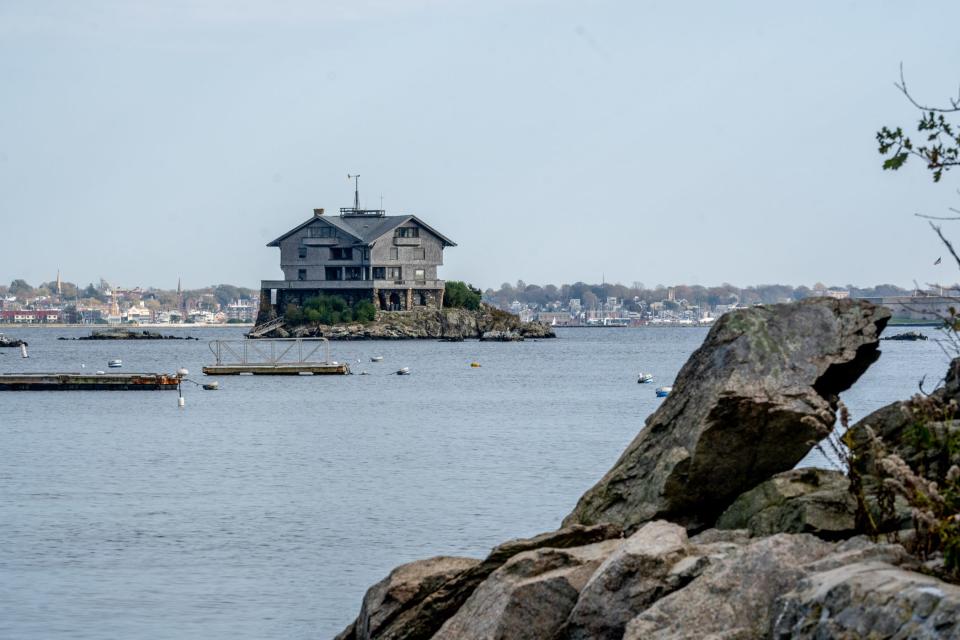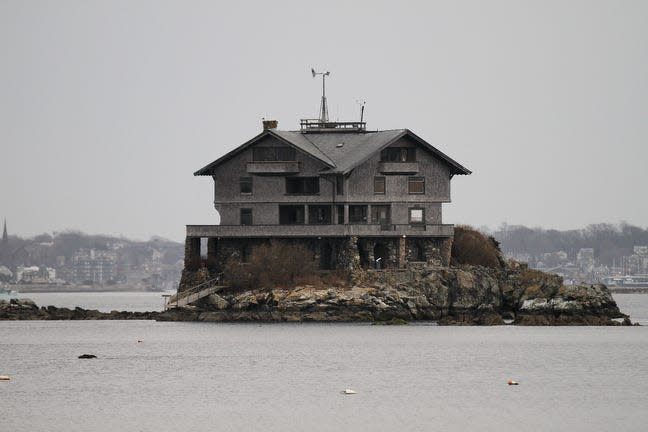What's the deal with the house on a rock off Jamestown's coast? Meet Clingstone
Off the southern tip of Jamestown, down by Fort Wetherill, there’s an impressive house sitting in the most peculiar spot: a large rock in Narragansett Bay.
The “house on the rock” takes up almost the entire boulder it sits on, seemingly one big storm away from being washed into the Bay. And yet the mansion, with its weathered, shingled siding, has been there as long as anybody can remember. It’s as much a fixture as the stone it sits on.
Which brings us to our What and Why RI question this week: “What’s the deal with that house on a rock off the coast of Jamestown?”

The history of the house on the rock called Clingstone
Set atop a rock formation called “The Dumplings,” the summer house is called Clingstone, not because it literally clings to the stone, but because of a comment by family friend James Dodge that it was “a peach of a house,” according to the Jamestown Historical Society.
Built for J.S. Lovering Wharton of Philadelphia, with the help of artist William Trost Richards, the house was completed in 1905 as a vacation home. The Whartons had previously had a home on the mainland, but in 1902, the government condemned that house to expand Fort Wetherill.
Wharton’s natural response was to build a three-story house, chock-full of windows, on a rock in the Bay. The design of the house was rugged, to suit its location, with a granite foundation, 12-by-14-foot white-oak ship timbers joined with wooden pins, and, most unusually, interior shingles in addition to the exterior ones.
Still, people were unconvinced this idea was going to work.
A 1904 article in the Philadelphia Press somewhat famously said, “Everyone is of the opinion here that Mr. Wharton will not stay in the house more than one season, and they say one nor’easter will settle it.”
But as evidenced by the fact that The Providence Journal is writing this article nearly 120 years later, the house did indeed last more than one season, endured more than one nor’easter, and even went through the 1938 hurricane with little damage. The breakwater was destroyed though, which also took out some exercise equipment, including some gymnasium bars and rings.
And the Whartons, by all accounts, loved the house, coming to stay every summer for decades. Their three sons, according to the family, would build model sailboats in the winter and bring them from Philadelphia to sail in the summer. Wharton died in 1931, and then his wife, Amelia Bird Shoemaker Wharton, continued to come until she died in 1957. A member of the Wharton family wrote to say that for a couple of years after the hurricane of '38, the family worked to make Clingstone "habitable, but the Philadelphia trust attorneys' patience ran out and the family abandoned hopes of restoring it."

Decades of decay, and then a renaissance under a new owner
Then came a stretch of time when the house was empty, during which it attracted the type of mischief that only a highly visible, empty house can. In one particularly notable example, two 14-year-old boys set off a pipe bomb in the house in 1957, ripping a hole in the wall and creating a boom heard a mile and a half away.
So it’s little wonder that by the time the house’s next owner, Boston-based architect Henry Wood, set eyes on it as a young man, it was in rough shape, with every one of its 65 windows smashed, holes in the roof, and even marbles mysteriously embedded in the shingles as if shot there, Wood told The New York Times.
Wood knew about Clingstone, telling WCVB, that as a child sailing around the bay, his father, who had a house in Newport, would point out the house on the rock and say it belonged to a distant cousin. But, it wasn't until Wood and his wife took a picnic to explore the abandoned house, and Wood saw the huge "For Sale, See Any Broker" sign that he thought about buying it.
The three brothers of the Wharton family who had become caretakers of the home reportedly disliked each other so much that they couldn’t agree on whom to sell the house to for the 20 years they let it decay and chased away vandals. But by the time Wood called and inquired about buying the house in 1961, they were so desperate to get rid of the beast that they sold it for far less than the original asking price of $5,000.
Wood and his wife bought it for $3,600 in 1962, exactly what the Wharton family owed in back taxes on the house. He often told interviewers that he thought the only reason they sold it to him was because he was a distant cousin.
For the first decade he owned the house, Wood told The New York Times it was an “albatross,” demanding so much more than he had time or money for. But he got scrappier.
He got good at talking friends into staying at the house to work, which eventually became the annual Memorial Day Work Weekend, where Wood would invite “pretty much anyone we know,” he told WCVB. He got good at talking people into giving him things for free, like doorknobs and light fixtures.
What and Why RI: Why does the Warwick Mall have a replica of the Independent Man? It's such a RI story.
And, perhaps most of all, he got good at selling people on the charm and roughness of his house in the sea.
Once, on a commuter flight from New York City to Boston, he reportedly coaxed the pilot into altering the course a bit to the east so it would fly above Clingstone.
Wood died in 2017. In his obituary, one of his three sons, Dan, lovingly wrote that Clingstone was the love of his father’s life.
What and Why RI: Once home to the first U.S. Navy commander, here's the story of the house on Admiral St.
What’s the deal with the house now?
Now, the house is still in the family and still the source of a lot of work weekends.
“My two brothers and I and respective families (with lots and lots of friends) continue to manage and caretake the house,” Dan Wood wrote in an email. “My dad passed away in 2017, after having spent most of his adult life restoring and working on the house. We do occasional rentals to trusted friends to help support the upkeep, along with many, many work weekends to try to keep things up!”
What and Why RI is a weekly feature by The Providence Journal to explore our readers' curiosity. If you have a question about Rhode Island, big or small, email it to klandeck@gannett.com. She loves a good question.
P.S.: If anyone has a photo of the Astro Horse that sat atop Astro Plating near the Big Blue Bug, please send Katie an email at klandeck@gannett.com. That's proven to be a tough What and Why RI question.
This article has been corrected to reflect the right date of death for Amelia Bird Shoemaker Wharton.
This article originally appeared on The Providence Journal: What’s with the house on a rock off Jamestown's coast? It's Clingstone

